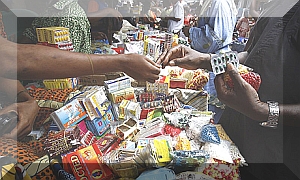Fake Drugs Endanger Africa's Billionth Child

 |
| Drug purchase: It is increasingly becoming difficult to identify fake drugs. Photo courtesy |
A consignment of fake anti-malaria drugs worth an estimated N10 million (approximately R500,000) was seized recently by the Nigerian National Agency of Food and Drugs Administration and Control (NAFDAC).
Fake drugs do not cure patients’ ailments. Usually they contain little if any active ingredient and often contain chemicals that not only fail to treat the underlying ailment but also cause direct harm to the patient. The World Health Organisation (WHO) estimates that counterfeit drugs constitute 10 per cent of the global drug market, rising to 25 per cent in developing countries and estimated to be worth approximately $75 billion worldwide. However, due to the very nature of counterfeiting where much of the trade goes undetected, the problem is likely to be more severe.
Counterfeit drugs that contain some, but not enough active ingredient are of particular concern because they increase the probability of resistance emerging to good quality drugs. They have the potential to render an entire class of drugs useless and introduce serious long-term implications for our ability to fight disease.
In the case of anti-malarial treatments there are few remaining drugs. The once highly successful malaria treatments, chloroquine, sulphadoxine pyrimethamine (SP) and mefloquine, have all been rendered completely useless as a result of wide-scale resistance. Even the most highly effective treatment, a drug called artemisinin, which is based on the age-old Chinese herbal treatment derived from the Artemisia annua plant, is now also showing signs of reduced efficacy.
In the Pailin area of Cambodia, patients given artemisinin take twice as long as those elsewhere to be clear of the parasite – 84 hours instead of the typical 48 and sometimes even as many as 96 hours. It is in this area of Cambodia where the first signs of resistance to chloroquine, SP and mefloquine emerged. Countless people have died as a result of the wide-scale resistance to these once highly effective treatments. If resistance to artemisinin develops, the situation will be disastrous because we have no new effective alternatives and it is unlikely that a vaccine will be commercially available within the next few years, despite the dramatic progress that has been made.
Early efforts by the private sector to control the prevalence of fake drugs, such as the introduction of trademarked branding and tamper-evident packaging systems, demonstrated some success, but these were soon copied by counterfeiters, making more drastic measures necessary. Current efforts focus on mass serialisations systems, using technologies based on barcodes or simple scratch panels. New technologies are also helping to alleviate the problem. For example, NAFDAC used a new hand-held Raman spectrometer to detect the fake drugs in Nigeria. Mobile phones that have become almost ubiquitous across developing countries enable purchasers of medicines to check the authenticity of their packs by sending the serial numbers to the manufacturer for confirmation.
In SA, the Medicines Control Council (MCC) is responsible for registering all new medicines and ensuring the efficacy of the drugs on the market. According to recent media reports, it is currently dealing with a backlog of nearly 3,000 medicines that could take another two years to resolve. Although some may consider it necessary to have a regulator to ensure that products are safe, it is no use if the delays caused by the size of the task are preventing life-saving drugs from entering the market.
For many years there has been discussion about harmonising drug regulation in the Southern African region, but if anything, things seems to have become less harmonized. There is little justification for the MCC, simply to fulfil a bureaucratic requirement, to withhold medicines from South Africa’s sick if some of these same drugs have already been registered for use in the United States,
Duplicating tests already conducted in advanced countries means the MCC is wasting time, money and jeopardising the health of SA’s citizens. The MCC should rather focus its attention on ridding the market of fake or sub-standard medicines by investing in new technologies such as the Raman spectrometers used by NAFDAC. Its failure to register genuine drugs in time is opening the door for fakes to enter the market. An urgent priority for the Department of Health is to reform the MCC so that it no longer remains a self-serving bureaucracy but starts to allow SA’s citizens access to internationally recognised life-saving drugs.
By Richard Tren, director of Africa Fighting Malaria and Jasson Urbach, director of the Health Policy Unit and of Africa Fighting Malaria. The views expressed in the article are the authors.’
